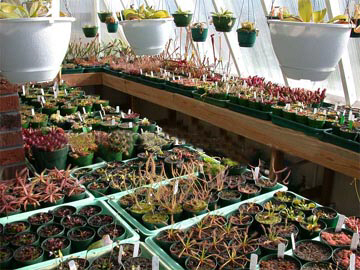

An Interview with a Professional Carnivorous Plant Grower An on-line interview between This and That and Mr. Michael Szesze, owner of the Carnivorous Plant Nursery.
While
searching the Internet for the best nursey from which to purchase
the Venus Fly Trap Plants for my collection, I was fortunate to
discover Mr. Michael Szesze's excellent website: The Carnivorous
Plant Nursery. This
outstanding site offered the widest selection of plant types
and sizes at the best prices on the Internet.
During an exchange of several emails with Mr. Szesze as he helped me get my collection of Venus Fly Traps started, I became curious about the behind-the-scenes aspects of growing carnivorous plants on a professional level. I asked Mr. Szesze if he'd be willing to be interviewed for an on-line article about himself and the Carnivorous Plant Nursery and he very graciously agreed.
The
Man Behind the Business:
Michael Szesze is an award-winning science teacher of 28 years. His accolades include National Science Foundation VIP-Outstanding Physics Teacher, Maryland Science Teacher-of-the-Year, and the Maryland Alternate to the NASA Teacher-In-Space Project. Michael's love and enthusiasm for science have inspired thousands of students and teachers alike in his classes, workshops, conference presentations and seminars. Michael's insight into excellence in teaching and learning express themselves in the high quality educational materials he has developed. These materials use help students explore the fascinating world of carnivorous plants as well as develop experiences with inquiry science. He has been raising carnivorous plants since childhood and is an accomplished photographer.
Mr. Szesze has been a popular and favorite participant in such venues as the Maryland Home and Garden Show, the Leesburg Horticultural Society Plant Sale, the Towsontown Spring Festival and many others.
The
Nursery:
The Carnivorous Plant Nursery has been selected for an Editor's Choice Award from the Awesome Library, a collection of the top 5 percent of sites in the field of education and the top site on Google for k-12 education. The Nursery was also honored by the Charles County Chamber of Commerce for "The Best Interior Exhibit" at their Home and Garden Show in Waldorf, MD, June 19-20, 2004.
Mr. Szesze's Nursery is the leading provider of engaging educational materials that use carnivorous plants to promote environmental stewardship, providing a complete line of low-cost, high-quality carnivorous plants from around the world, as well as teaching materials for carnivorous plants. It's a one-stop shop for carnivorous plants and useful information on their care and culture. All of the plants for sale from the nursery nursery-propagated from seeds, cuttings, divisions, and tissue culture.
Michael Szesze is happy to provide tours of his nursery and only requests that an appointment be made ahead of time. The address is:
Carnivorous Plant Nursery
Michael
Szesze
Owner-operator
16128
Deer Lake Road
Derwood,
MD 20855
phone:
301-519-7505
URL: http://www.carnivorousplantnursery.com
email: [email protected]
Images from the Carnivorous Plant Nursery (Note: All images except those marked with an "*" are copywrited by Mr. Michael Szesze.)

A small part
of the extensive green house facility used to grow
thousands of
carnivorous plants every year.
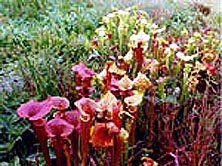
Red Flava plants growing outside.
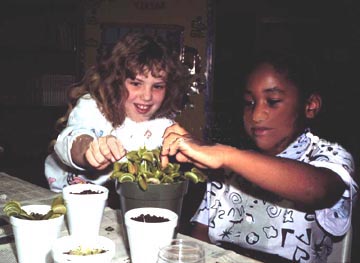
Children
learning about Venus Fly Traps during a program
supported by
the Carnivorous Plant Nursery
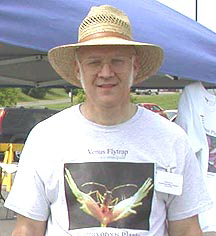
Mr. Michael Szesze, wearing a teeshirt with his world famous logo.
The
Interview:
Mr. Szesze, thank you very much for taking time out of your busy schedule for this interview.
I'm happy to do it.
The
biography on your site mentions that you've been interested in
carnivorous plants from your early youth. What was the first
insect-eating plant you had?
My first carnivorous plant was a venus flytrap. I was 12 years old. It didn't last long. I thought I had killed it. If I knew then, what I know now, I would have realized that I was treating it like a normal house plant and forced it into dormancy. Had I provided the right CP conditions (constantly moist, acid soil, etc), it would have come back and done well for me, I'm sure.
Do you have a favorite species and variety? If so what is it and why is it your favorite?
I remain fascinated by Dionaea muscipula, the venus flytrap. I really like the giant forms, especially Low Giant, because of its tendency toward low growing traps. I must admit Drosera capensis red form (the Red Cape Sundew)
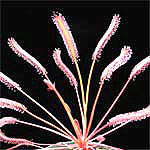
Drosera Capensis
and Drosera multifida extrema (the Staghorn Sundew) also rank high on my list. Their glistening dew in the morning light or winter afternoon light is really beautiful.
How did you end up geting into the business of selling carnivorous plants? Was this always your dream or was it something that developed over the years?
As a school teacher, I learned early on how powerful CPs are with students. They are an incredible way to promote inquiry-based instruction that leads to lots of questions and experimentation. They also are great avenues to students learning about the value of wetlands and environmental stewardship. The more I worked with students, the more I found the need for a large supply of quality plants. I began learning how to propagate them, and soon was giving talks at teacher's conventions about using CPs in the classroom. Folks would ask where they could get such nice CPs and I said, well, they could get them from me...Carnivorous Plant Nursery was born.
What year did you begin selling carnivorous plants?
I've been selling CPs now since around 1995 and started up my website, http://www.carnivorousplantnursery.com, in 2003.
How many square feet do you have in your greenhouses and in your outside propagation areas?
By commercial standards I am small. My first greenhouse was just over 300 square feet. I now have a solar greenhouse at 480 square feet, with plans to double that soon. There are a number of outdoor "bog boxes" in the areas adjacent to the greenhouse. A typical bog box is 3x4 feet by 12 inches high, lined with UV plastic and filled with CP soil.
About how many total plants of each kind do you have?
You can see from the website that I have a great variety of many different kinds of CPs. Typically there are dozens of each at the mature size and hundreds working their way up from starts. I never counted them all. I do know that visitors often comment on the fascinating collection.
What is the most popular plant you sell?
By far that would be the venus flytrap, perhaps Big Mouth.
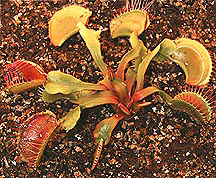
Big Mouth Venus Flytrap *
Folks order a lot of the Cephalotus as well.
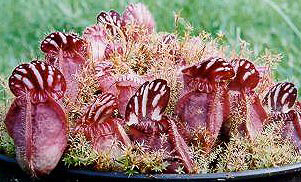
Cephalotus (a pitcher plant) *
Believe it or not, I get a lot of requests for live Sphagnum moss too.
Approximately how many carnivorous plants you sell per year?
Well, it keeps increasing all of the time, which is great. A few years ago it was 100s, now its 1000s.
Growing so many plants must take a lot of time. Do you do all the work yourself or do you have employees that help?
Right now it's me, Michael, owner/operator and fascinator of CPs. Its great fun and I love it. If folks keep ordering so many of my quality CPs that may soon change. Need a job?
(Laughing) It's tempting!
Feeding all your plants could take a lot of time. Do you let them catch their own food or do you hand feed them?
I do not feed the plants. Nature has done such a wonderful job at allowing the plants to lure, catch and digest insects all on their own. They do not need by help. The greenhouse is open and vented with 1/4" mesh in the warm season and plenty of insects are lured in. I will admit to bring in clusters of flies and other insects when they are convenient.
When you hand feed plants, what types of insects do you prefer to use?
I do hand feed some plants for demonstrations and my movies. I usually use wingless fruitflies, since they cannot fly and crawl right up the plants into the traps. They put on a great show. Of course some plants need larger prey. I have used wasps and houseflies often.
I believe you ship plants around the world. What is the most unusual place to which you've sent one of your plants?
I had an unusual order from a sailor aboard ship. It was interesting to work out the timing for him, so the plant arrived in good condition.
What percent of your sales are US and what are overseas?
Most sales are from customers here in the US. I would say about 10% are international.
Growing as many plants as you do must require a lot of distilled water. Do you have your own reverse-osmosis plant to provide it in an economical way?
I buried a 1000 gallon cistern in the ground and collect rainwater from the gutters. A good 1-2" inch rain fills it up nicely. I use a filtering system before the water enters the tank. There is a pump in the cistern connected to the greenhouse and bog box watering systems. It's nice to have clean rainwater on tap.
What are the hardest and easiest carnivorous plants to grow?
For me the hardest to grow is Darlingtonia, the Cobra.
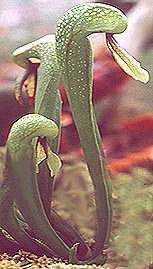
Darlingtonia *
It requires cooler conditions than I can easily maintain. The easiest would be the droseras that come up as "weeds" in the greenhouse; D. capensis and D. spathulata. They can spread like wildfire.
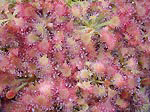
Drosera Spathulata (a sundew)
What is the most frequently asked question you get about carnivorous plants?
It depends a lot on where I am. At weekend shows with the general public, I often hear, "How often do you have to feed these plants?" Folks on the web are generally more CP Savvy, I frequently get asked, "Which is the largest VFT?" or I get asked about how to grow a particular plant. I enjoy answering the questions from them all.
What is the most common mistake people new to growing carnivorous plants make?
I think the most common error is treating the CPs like regular houseplant, i.e. letting them dry between waterings, using tap water, repotting with african violet potting soil, and not letting the plants that need dormancy have dormancy. I remind people of the need to reproduce the environment to which the CPs are native--the bog. If you can plant it close to the conditions of its habitat, you should have great success. The trick here is learning to know its native habitat.
How large was the largest trap you've ever seen on a Venus Fly Trap?
I have seen traps the size of half dollars, over 1.5" across. I have a few very mature plants that will show traps this size by the end of a good growing season.
What are the most unusual and rarest carnivorous plants in the world?
I've always been fascinated by carnivorous fungus and have always found them hard to come by.
What is the most beautiful carnivorous plant?
I find the classic shape and gorgeous coloring of Dana's Delight, S. willisii x leucophylla, to really stand out in the crowd.

Dana's Delight (a pitcher plant)
What is the largest carnivorous plant?
I believe the Nepenthes produces the largest plants because of it's a vine with a climbing habit. One plant can be over several meters in length. The traps can also get to be huge--catching large frogs, birds, etc.
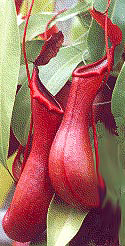
Nepenthes (a pitcher plant) *
Is there anything like a plant growth hormone that can cause them to grow larger than normal?
Gibberlic Acid can have this effect on other plants. I have never tried it on CPs.
I enjoyed browsing through your extensive website. How many visitors a year does it get?
http://www.carnivorousplantnursery.com is visited by millions every year. It is a site loaded with valuable information and educational activities and is dedicated to promoting environmental stewardship through education. You can find really cool CPs for sale too.
Thank
you again for agreeing to this interview. I'm sure many people will
enjoy reading it.
It was my pleasure.
I wish to express my appreciation to Mr. Szesze for taking time out of his busy schedule to work with me in creating this page. I hope the visitors to This and That have found it interesting and informative. I encourage everyone will pay Mr. Szesze's site at http://www.carnivorousplantnursery.com a visit.
Return to my main site for more gardening pages or browse over 90 other topics: everything from electric rocket engines to Knitting Nancys.